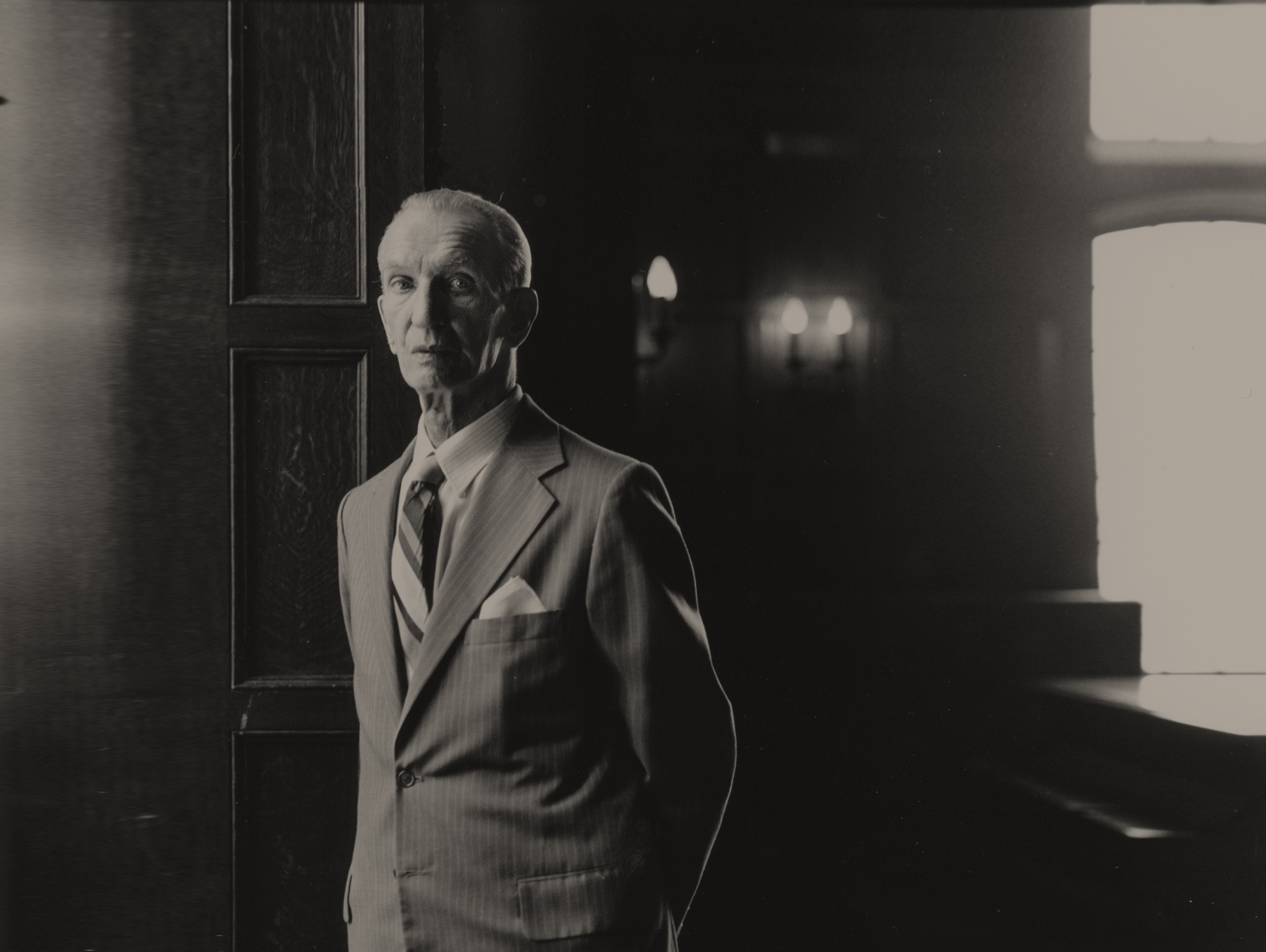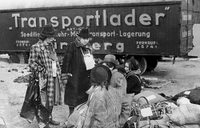KARSKI IN A CAMP
A few days after my second visit to the Warsaw ghetto, the Bund leader was to arrange an opportunity for me to see a Jewish death camp. The camp was located near the town of Belzec, about one hundred miles east of Warsaw, and was well-known all over Poland from the tales of horror that were circulated about it. The common report was that every Jew who reached it, without exception, was doomed to death. That was the only reason to be sent there. The Bund leader had never been in it but had the most detailed information in its operations, which he had had principally from the Polish railroad workers. [...]
I was to wear the uniform of one of the Estonians (Please note: historians have demonstrated that Karski actually wore the uniform of a Ukrainian guard but wrote in 1944 that it was Estonian in order to protect those who had helped him) who would stay home while I went in with his papers. [...] I was assured that chaos, corruption, and panic prevailed in the camp to such an extent that there was no chance of my disguise being penetrated. Moreover, the whole expedition was perfectly organized in advance. [...] I would go through a door habitually guarded only by Germans and Ukrainians, for an Estonian might sense a stranger in me. The Estonian uniform, itself, constituted a pass, so that my papers would probably not be inspected. [...]
The plan seemed simple and flawless. I agreed without any hesitation and without the slightest fear of being caught.
Early in the morning of the day we had selected, I left Warsaw in the company of a Jew who worked outside the ghetto in the Jewish underground movement. We took the train to Lublin. A hay cart was waiting for us there. [...] We arrived in Belzec shortly after midday and went directly to the place where the Estonian was supposed to be waiting to give me his uniform. It was a little grocery store that had once belonged to a Jew. [...] An hour or two later the Estonian who was to accompany me arrived. [...] The camp was about a mile and a half from the store. [...]
As we approached to within a few hundred yards of the camp, the shouts, cries, and shots cut off further conversation. I again noticed, or thought I noticed, an unpleasant stench that seemed to have come from decomposing bodies mixed with horse manure. [...]
It was on a large, flat plain and occupied about a square mile. It was surrounded on all sides by a formidable barbed-wire fence, nearly two yards in height and in good repair. Inside the fence, at intervals of about fifteen yards, guards were standing, holding rifles with fixed bayonets ready for use. Around the outside of the fence, militia men circulated on constant patrol. The camp itself contained a few small sheds or barracks. The rest of the area was completely covered by a dense, pulsating, throbbing, noisy human mass Starved, stinking, gesticulating, insane human beings in constant, agitated motion. Through them, forcing paths if necessary with their rifle butts, walked the German police and the militia men.
To my left I noticed the railroad tracks which passed about a hundred yards from the camp. From the camp to the track a sort of raised passage had been built from old boards. On the track a dusty freight train waited, motionless. It had at least thirty cars, all filthy. [...] The Jewish mass vibrated, trembled, and moved to and fro as if united in a single, insane, rhythmic trance. They waved their hands, shouted, quarreled, cursed, and spat at each other. Hunger, thirst, fear, and exhaustion had driven them all insane. [...] When they had been rounded up they were given permission to take aboutten pounds of baggage. [...] On the train, the Germans who accompanied them stripped them of everything that had the slightest value, even snatching away any article of clothing to which they took a fancy. [...]
Those who left the train without any food starved continuously from the moment they set foot in the camp. [...] The sheds could not accommodate more than two to three thousand people and every ‘batch’ included more than five thousand. This meant that there were always two to three thousand men, women, and children scattered about in the open, suffering exposure as well as everything else.The chaos, the squalor, the hideousness of it all was simply indescribable. There was a suffocating stench of sweat, filth, decay, damp straw and excrement.
Karski in a Camp, Izbica Lubelska, Summer of 1942
‘Ruhe, Ruhe! Quiet, quiet! All Jews will board this train to be taken to a place where work awaits them. Keep order. Do not push. Anyone who attempts to resist or create a panic will be shot.’He stopped speaking and looked challengingly at the helpless mob that hardly seemed to know what was happening. Suddenly, accompanying the movement with a loud, hearty laugh, he yanked out his gun and fired three random shots into the crowd. A single, stricken groan answered him. He replaced the gun in his holster, smiled, and set himself for another roar:
‘Alle Jüden, ’raus – ’raus!’
For a moment the crowd was silent. Those nearest the SS man recoiled from the shots and tried to dodge, panic-stricken, toward the rear. The shots continued without let-up from the rear and now from the sides, too, narrowing the mob down and driving it in a savage scramble onto the passageway. In utter panic, groaning in despair and agony, they rushed down the passageway, trampling it so furiously that it threatened to fall apart. [...]
The military rule stipulates that a freight car may carry eight horses or forty soldiers. Without any baggage at all, a maximum of a hundred passengers standing close together and pressing against each other could be crowded into a car. The Germans had simply issued orders to the effect that 120 to 130 Jews had to enter each car.
These orders were now being carried out. Alternately swinging and firing with their rifles, the policemen were forcing still more people into the two cars which were already over-full. The shots continued to ring out in the rear and the driven mob surged forward, exerting an irresistible pressure against those nearest the train. These unfortunates, crazed by what they had been through, scourged by the policemen, and shoved forward by the milling mob, then began to climb on the heads and shoulders of those in the trains.
Then the policemen slammed the doors across the hastily withdrawn limbs that still protruded and pushed the iron bars in place.The two cars were now crammed to bursting with tightly packed human flesh, completely, hermetically filled. All this while the entire camp had reverberated with a tremendous volume of sound in which the hideous groans and screams mingled weirdly with shots, curses, and bellowed commands. [...] The floors of the car had been covered with a thick, white powder. It was quicklime. Quicklime is simply unslaked lime or calcium oxide that has been dehydrated. Anyone who has seen cement being mixed knows what occurs when water is poured on lime. The mixture bubbles and steams as the powder combines with the water, generating a large amount of heat.Here the lime served a double purpose in the Nazi economy of brutality. The moist flesh coming in contact with the lime is rapidly dehydrated and burned. The occupants of the cars would be literally burned to death before long, the flesh eaten from their bones. [...]
Secondly, the lime would prevent decomposing bodies from spreading disease. It was efficient and inexpensive – a perfectly chosen agent for their purposes.
My informants had minutely described the entire journey. The train would travel about eighty miles and finally come to a halt in an empty, barren field. Then nothing at all would happen. The train would stand stock-still, patiently waiting while death penetrated into every corner of its interior. This would take from two to four days.The entire process of disposal would take, then, from three to six days. During this period the camp would have recruited new victims. The train would return and the whole cycle would be repeated from the beginning.



